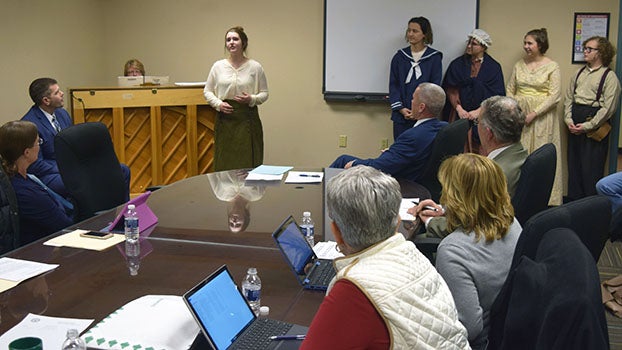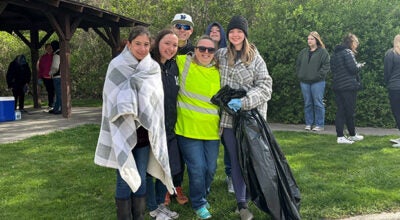SMC raising tuition for 2020
Published 8:56 am Wednesday, February 27, 2019

- SMC Trustees listen to a sneak-preview Monday of the spring musical “Sweeney Todd,” which opens Thursday night, continues Friday and Saturday at 7:30 and concludes with a 2 p.m. matinee Sunday. From left: Kayla Rose, Michael Hayes, Brittany Schesnuk, Megan Yacobozzi and Noah Yardley. (Submitted photo)
DOWAGIAC — The Southwestern Michigan College Board of Trustees adopted the tuition and fee schedule for the 2019-2020 fiscal year at its regular meeting Feb. 25 on the Dowagiac campus.
Tuition increases $2.25 per contact hour (1.9 percent) for in-district students and $3.50 (2.2 percent) for in-state with $1 registration fee and 50-cent technology fee adjustments.
The board addresses tuition at this time of year to provide certainty to students who begin signing up for fall classes March 27, said SMC officials.
Along with $4 million in need-based Pell Grants and $825,000 in SMC scholarships, the college provides much-needed help for students to fulfill their higher education goals, Board of Trustees Chairman Thomas F. Jerdon said.
“SMC has always had a balanced budget despite historical financial challenges,” Jerdon said. “Currently, state appropriations are about the same as they were 17 years ago. Property tax revenue from the district is one of the poorest in the state. Legacy costs rise each year. Thus, the modest proposed tuition increase is the minimum needed to maintain SMC’s outstanding educational value of small class sizes, exceptional facilities and technology, great faculty and staff and robust offerings. SMC remains a great bargain for our students and families.”
Trustees also heard a presentation by Vice President of Student Services Dr. Joseph Odenwald about positive strides made in student retention, which increased 2.3 percent from fall to spring compared to the previous year. Fall retention for first-time students at any college increased 7.8 percent — a five-year high.
“This is tied for the highest since 1991, when we started measuring it,” Odenwald said. “According to the Community College Benchmarking Project, this puts us in the 90th percentile.”
Odenwald credited significant academic and social engagement for the gains.
“Our instructional division has spent many years revamping our curriculum for student success, removing barriers and creating pathways, with pilot programs in lower-level courses. We had high levels of student social engagement with fall activities. Welcome Week surveys revealed 66 percent of respondents found the week extremely or very helpful in making them feel welcome to campus,” he said.
In 2018, 325 first-time students attended 126 events hosted by organizations.
“We can go even further than the theoretical answer borne out in fall semester data,” Odenwald said. “We are fortunate to abide on a safe, well-manicured campus. Year after year, students tell us they are increasingly satisfied with our facilities and our friendly and helpful faculty and staff. In sum, it’s a product of a collective effort — not one thing, one program or one person.”
Quoting Syracuse University Professor Vincent Tinto, Odenwald said, “The answer to the question of student retention which we offer is not simple (but) it is achievable within the confines of existing institutional resources. It springs from the ongoing commitment of an institution of its faculty and staff to the education of its students.”
Also Monday, Manager of Theatre Operations and Applied Performing Arts Marcus Roll and five cast members treated trustees to a sneak-preview of this weekend’s spring musical, Stephen Sondheim’s “Sweeney Todd,” which opens Feb. 28 and continues March 1, 2 and 3 in the theatre of the Dale A. Lyons Building.
Roll highlighted his cast’s partnership with the art department to create props and the drawing class using the set to inspire projects. “It’s also great to have a supportive administration and a maintenance department willing to help make adjustments for the theatre program,” including crafting a steel barber’s chair.






